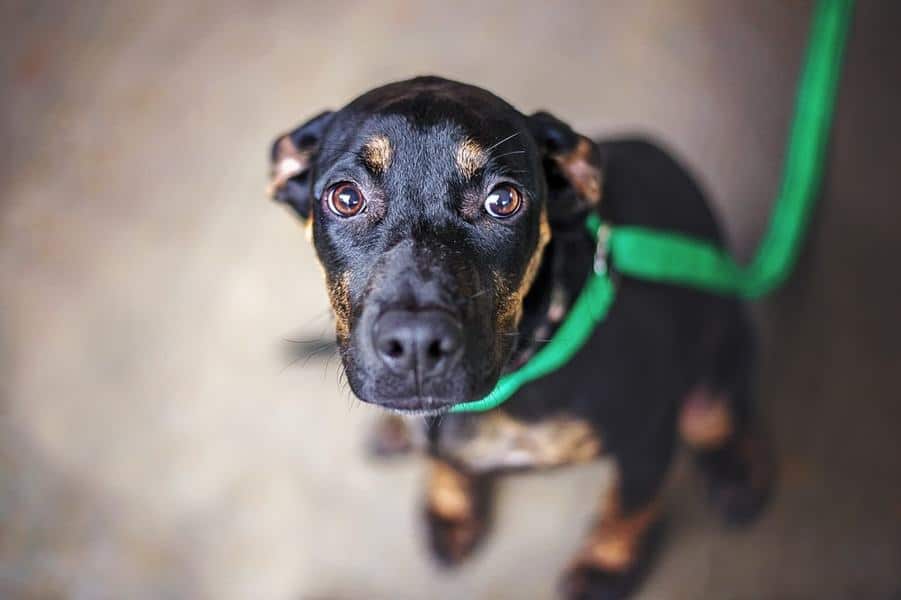
Understanding what your dog does when he is uncomfortable, anxious, or stressed out can help you monitor his stress levels, calm him down, or remove him from stressful situations.

Stress is often a precursor to aggressive or anxious behavior, so if you have a dog who has these issues, here are some of the signs that you should be watching for:
- A slow wag of the tail – When your dog wags his tail quickly and excitedly, you know that he is happy. When he wags it slowly, however, this is a not a sign of happiness, it’s a sign of stress. Pay attention to the speed and enthusiasm behind a tail wag to understand how stressed (or not) your dog might be.

 Tucked tail – We’ve all seen a dog with a tail tucked between its legs and assumed that this is a submissive or frightened response. Fear is simply an extreme version of stress. This is a good indication that a docile dog is very frightened and might even be a sign that an aggressive dog is could be about to strike.
Tucked tail – We’ve all seen a dog with a tail tucked between its legs and assumed that this is a submissive or frightened response. Fear is simply an extreme version of stress. This is a good indication that a docile dog is very frightened and might even be a sign that an aggressive dog is could be about to strike.- No appetite – If your dog was happily eating just a moment ago, but now will not touch their food (even their favorite treat) this is a very good indication that there is something in your dog’s environment that is causing him stress. A dog with no appetite can be an indicator of many other issues as well, so make sure to take note and action if your pup isn’t interested in his dinner.
- Doesn’t want to play – Especially if your dog is always ready and willing to play, not wanting to play or playing for a moment and then dropping the toy or abandoning the game is a great indication that your dog is experiencing a high level of stress. This is a response very similar to their human counterparts. We humans often won’t want to engage in activities when something has us stressed out either. If you notice this (especially at a dog park), this is a good time to remove your dog from the situation.

 Pinned back ears – Ears are one of the primary sources of communication between you and your dog. You can tell a lot about what your dog is thinking or feeling by how their ears are behaving. If they are holding their ears low against their head, this means they are feeling stressed. You can know that your dog is no longer feeling stress when they lift up and are no longer pinned back.
Pinned back ears – Ears are one of the primary sources of communication between you and your dog. You can tell a lot about what your dog is thinking or feeling by how their ears are behaving. If they are holding their ears low against their head, this means they are feeling stressed. You can know that your dog is no longer feeling stress when they lift up and are no longer pinned back.- Blinking and squinting – Of course, your dog will naturally blink, but if you notice that your dog is blinking more often than he normally is or that he is squinting at you, both of these are signs of mild stress. This might not mean that you need to remove your dog from the situation. Monitor him to see if any other signs of higher stress levels crop up.
- Holding his breath – Paying attention to the breathing patterns of your dog in a situation can be a great way to know your dog’s stress level. If he is holding his breath, this may be an indication that he is about to lash out at something he is finding stressful. Again, this is a good sign that you need to take your dog out of that situation. Puffing is another sign of potential aggression.
- Panting – Humans sweat when we are stressed out. Because dogs do not sweat, they sometimes pant when they are stressed. If your dog has not been doing any significant physical activity but is panting, this probably means that he is stressed and needs to be taken away from the stressor.
When we’re training dogs in Sarasota, our goal is to help people enjoy life with their best friend. And, you wouldn’t want your best friend to be stressed out, right? So, keeping an eye out for these indicators are great ways to keep your best friend happy and healthy. Cheers!
Jillian Vogel is the owner at Gulf Coast K9 Dog Training in Bradenton, Florida. Originally from the Buffalo NY area, Jillian entered the dog training industry to follow her love for dogs and animals in general. She is passionate about helping dogs overcome hurdles and obstacles, and helping people to live a better life with their best friend.


